MEET ME BY THE ARROYO?
MEGAN WEI HOLZRICHTER

Rhode Island School of Design
Undergraduate Architecture Thesis
Megan Wei Holzrichter
2024
In Gratitude:
Thank you for supporting me in this endeavor by lending me your voice as well as an ear. This project could not have existed without you guys.
Cheng Wei
Michael Holzrichter
Lily Gucfa
Samuel Leung
Jiyou Kang
Peiyu Hung
Richard D.
Jadyn Gardner
Ryan Love
Kaci Jarry
Celeste Rudolfo
Ryan Sotelo
Amelyn Ng, Advisor
Debbie Chen, Secondary Advisor
Gabriel Feld, Mentor
ar·roy·o /ɘ’roi,(y)ō
Water drainage channels found in sloped desert terrains, primarily dry but sometimes wet*.
* Especially during monsoon season.
CONTENTS

FRAMING TEXTS + PROJECTS
Influences and Guideposts
Experiential Archive
Material Studies + Interventions
Urban Acupuncture
Exhibition + Joy of Collaboration
1 6 INTRODUCTION WHERE TO BEGIN?
DESIGN IN PRACTICE THE FIELD NOTES THE COOKBOOK SCALING UP 2 7 3 4 5
Why the Arroyos? A Case Study
MEET ME BY THE ARROYO?
This thesis is a meditation on and exploration of design and urban development through reciprocity, gratitude, placemaking, and environmental stewardship. It advocates for grassroots change over top-down planning, celebrating arroyos and their revitalization to create dynamic public commons that balance human and non-human ecologies.

1
INTRODUCTION
Why the Arroyos?

Growing up in Albuquerque, it was common to hear a friend tell you to “meet me by the arroyo.” It was a call to play and congregate, to engage in somewhat unsupervised play where the imagination can run free.
The typical response is, “Which one?” Due to the city’s location between the Sandia Mountains and the Rio Grande, the arroyos are plentiful and an integral
a.
b:
part of the city’s urban landscape. Their presence is pivotal in replenishing the aquifer, a critical resource in the desert environment where water is both valuable and painfully finite. These waterways are also home to the Desert Dry Wash Biome.
However, as the city developed, we covered the landscape with impermeable materials like asphalt, concrete, and stone, extending into many arroyos.
of Arroyo paths through Albuquerque Map of impervious surface coverage in Albuquerque
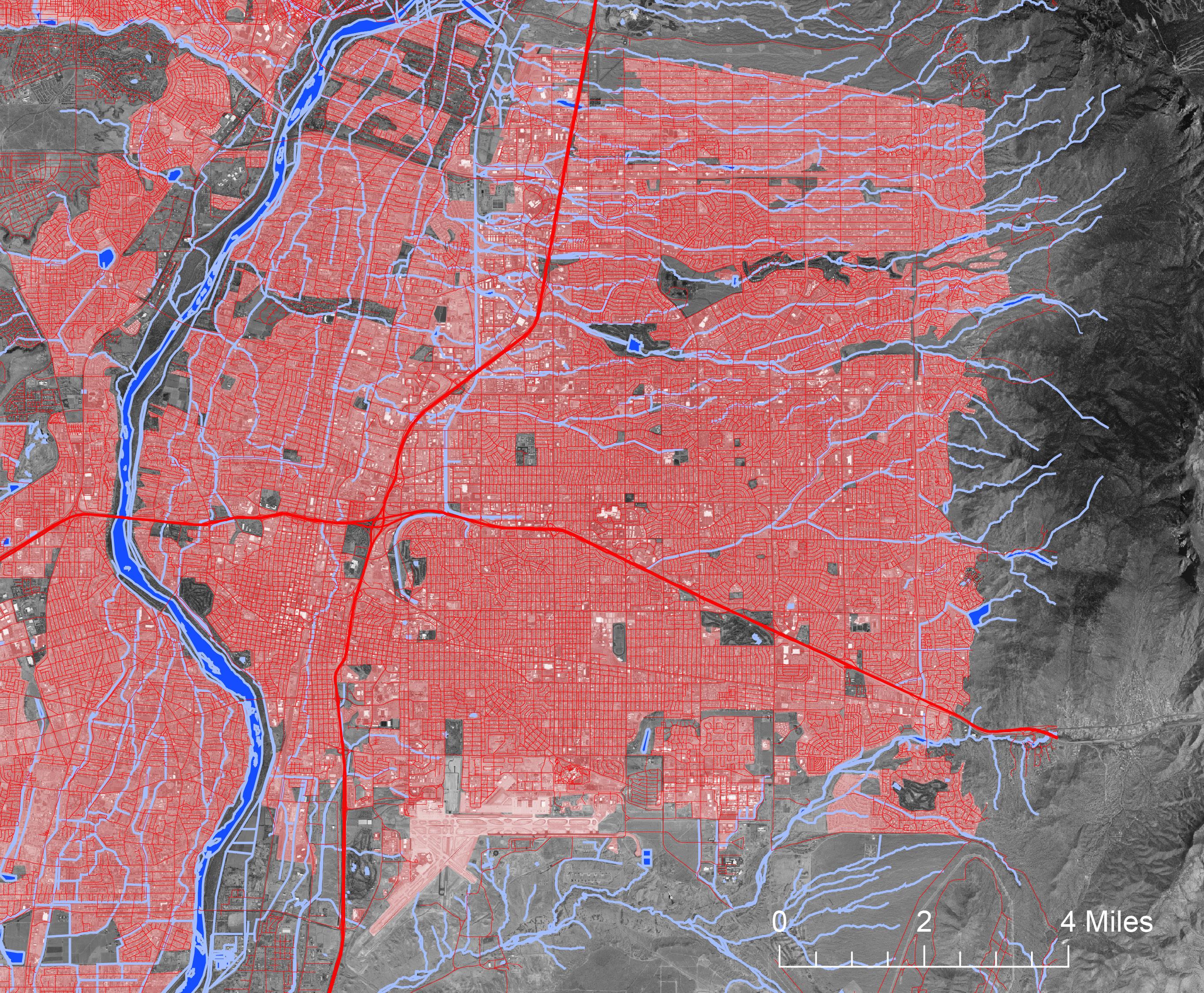
b.
a:
Map
In an effort to control and to still the landscape, most arroyos running through the city were channelized, resulting in their current appearance.



This process has exacerbated danger during heavy rainstorms, creating a feedback loop of fear among the public and driving further control efforts.
Additionally, channelization, alongside prevalent material biases and “typical” building practices, further separate us from the land and hinder our engagement with the environment’s infrastructure. It often seems that the scale we look at regarding the space we inhabit is centered around the scale of the above grade built environment, extending not much deeper than the foundations
Undisturbed Arroyo Section
You are here
Channelized Arroyo Section
In actuality, the scale we should also concern ourselves with is much bigger, and deeper. Then, we can begin to realize how such a thin layer can have such profound impacts below the surface. We’re not just blocking water access to the ground; we’re also hiding and severing our connection to it. The homogenization of the landscape and our detachment from local ecological knowledge has impeded our capacity to engage in a meaningful dialogue with the environment’s infrastructure during design and urban development.
In the end, we exist in the Anthropocene, which means that the notion of going back to a fully “natural” landscape is impossible. What we can focus on however, is working towards a landscape that exists between the two extremes of human occupation – a hybrid that creates a bond between the inhabitants and the space they inhabit.
You are here

Undisturbed Arroyo Section Something In between
Channelized Arroyo Section between

2 FRAMING TEXTS +
PROJECTS
Influences + Guideposts
From the very beginning, this project grew from and is informed by a multitude of writings, projects, and philosophies across multiple disciplines.
Nothing exists in a vacuum.
Robin Wall Kimmerer, Braiding Sweetgrass, (Minneapolis: Millkweed Editions, 2013)
Reciprocity, gift economy, remembrance, stories, individual vs. the collective
Lina Bo Bardi, Stones Against Diamonds, (London: AA Publication, 2013)
Rawness, Uniqueness in imperfections, social connections, local culture
Chelsea Steinauer-Scudder, Counter-Mapping, (Emergence Magazine, 2018)
Remembering, mapping, listening, interwoven stories and experiences
Georges Teysott, The American Lawn, (Princeton: Princeton Architectural Press, 1999).
American identity, cultural landscape, horticulture and architecture
Albuquerque and APS, Albuquerque’s Environmental Story,(Albuquerque: City of Albuquerque, 2008)
Collective, local ecosystems, caring, sustainable thinking
Eric Klinenberg, Palaces for the People, (New York: Crown Publishing, 2018)
Social resilience, third spaces, community, connections
AMAFCA, AMAFCA Summary, (Albuquerque: City of Albuquerque, 1998)
Urbanization, minimize flood dangers, floods in the desert
Anna Lowenhaupt Tsing, The Mushroom at the End of the World, (Princeton, Princeton University Press, 2015)
Anthropocene, Post-Industrial Landscapes, Capitalism, Resiliance
DEPT, Prairie Plots, Living Installation, 2022
Heterogeneity vs homogeneity, lawn, alternative landscapes
LANDING Studio, Plymouth River Herring, Pop-up Installation, 2021
Demystifying, emotional attachment, local ecosystem, unseen practices
Material Cultures, Rock Hut, Pavilion, 2020
Conscientious materialism, collaboration, post-carbon future
ADHOC, Your Place at the Table, Installation, 2020
A+A+A, Healing Spaces, Installation, 2020
Third spaces, public space, relaxation and rest, community building Social resilience, third spaces, healing, community participation, joy of collaboration
Amelyn Ng, Christine Giorgio, Gabriel Vergara.
D.E.P.O.T, Ongoing
Labor of salvage, material supply chains, waste work, unmaking and remaking of the built environment
Cynthia Deng, Brooks Hill Bothy, 2023
Conscientious materialism, multiple ecologies, reuse
Sophie Westen Chien, Practice, 2020
Community Power, Environmental Justice, Policy Design

Landscape interconnected through layers and time

3 ARROYO FIELD NOTES
Experiential Archive
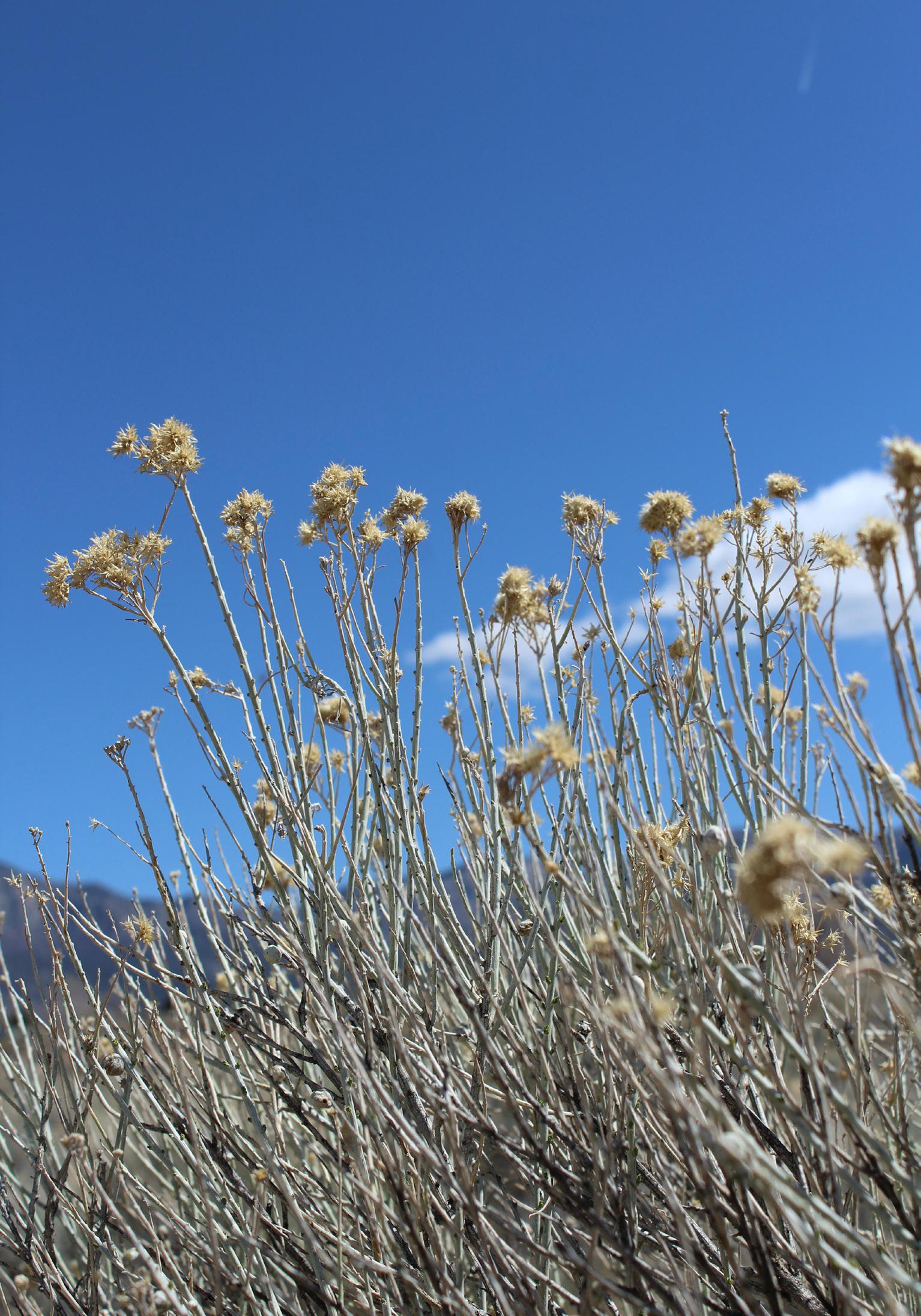
This project envisions a reality where the design and process of change begins with an “experiential archive” - the arroyo field notes. The archive serves as a lasting platform for documenting various materials related to the arroyos, including books, projects, essays, artworks, and more. The subject and history of the arroyos are expansive, offering both excitement and challenges.
The experiential archive encourages people to explore the arroyos, fostering a deeper connection with these spaces in the process. It prompts collaborators to observe and document aspects that may have been previously overlooked, creating a pool of data rooted in personal experiences and deeply resonant.
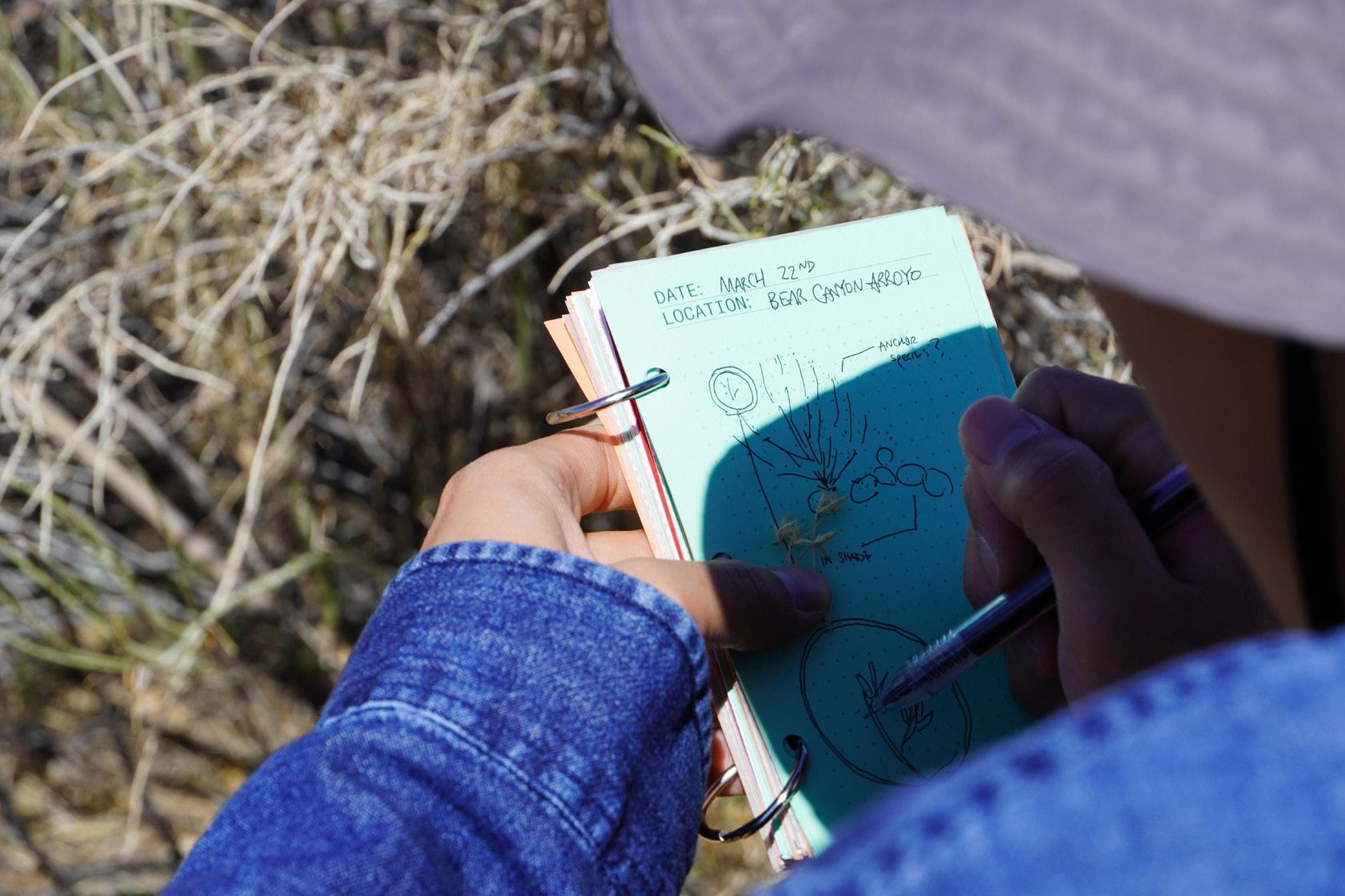

Contributor: Megan Holzrichter

Contributor: Jiyou Kang
It is a collaborative effort, existing both physically and digitally and welcoming contributions from a diverse community of voices.
To access and contribute to the digital archive, scan the QR code, or click on the link.
https://arroyofieldnotes.cargo.site/

4 ARROYO COOKBOOK
Material Research + Interventions
Working alongside the field notes is the arroyo cookbook, a collection of material research in the form of “recipes”. It’s a record of the embodied process of designs and their iterations that is available for current and future readers to build and build on past entries and even add their own.
It explores alternative building blocks utilizing adobe construction practices and resources from channelized arroyos, aiming to create a “cradleto-cradle” cycle for concrete and construction waste found on site. This gives an opportunity to transform materials that once hindered ecosystems into structures that promote site regeneration.
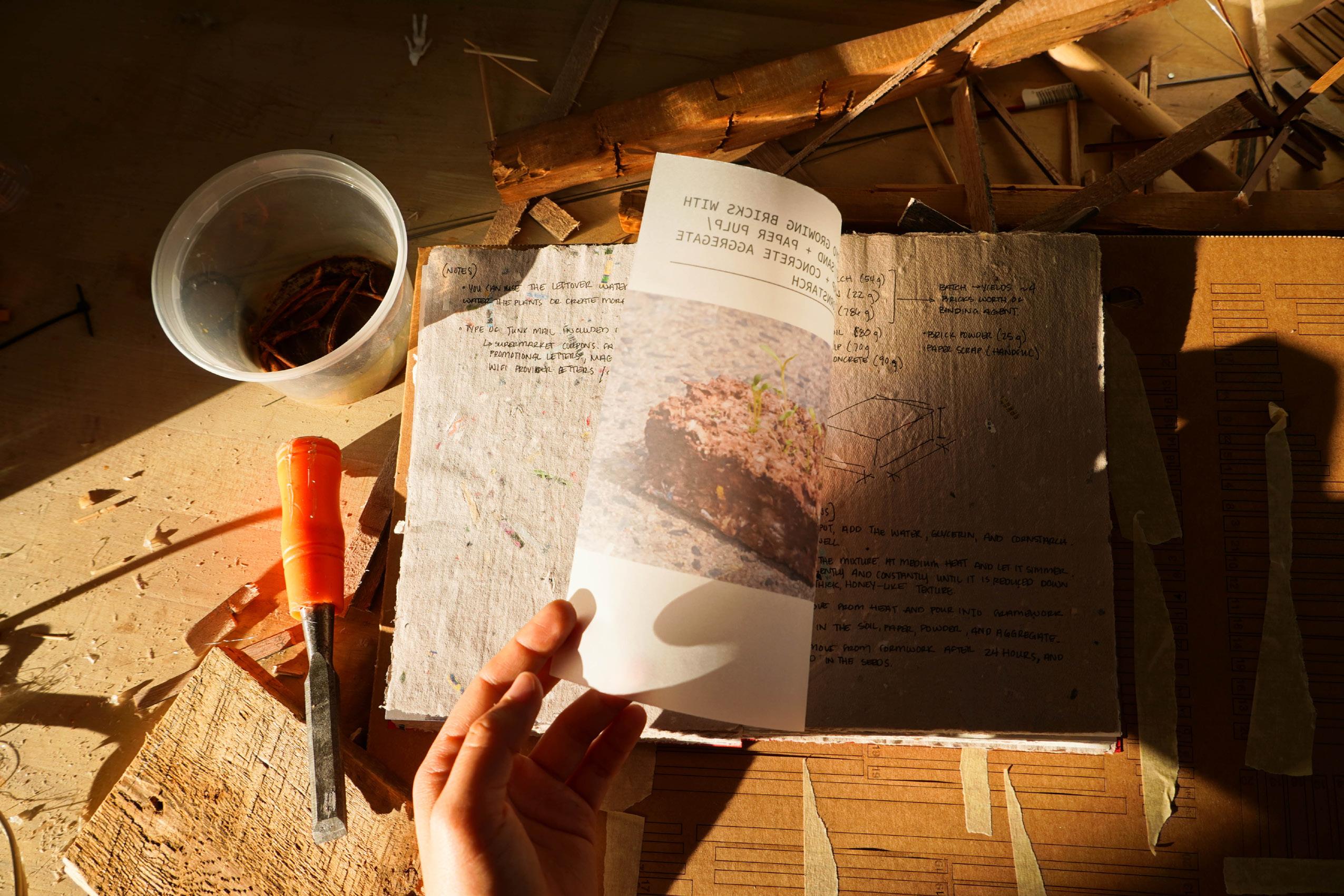

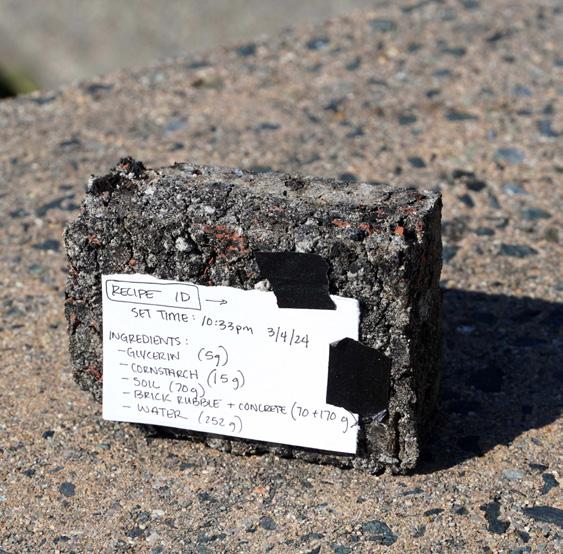




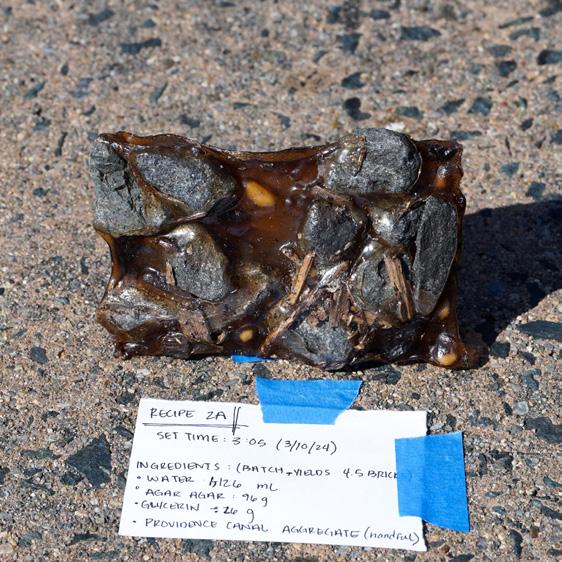
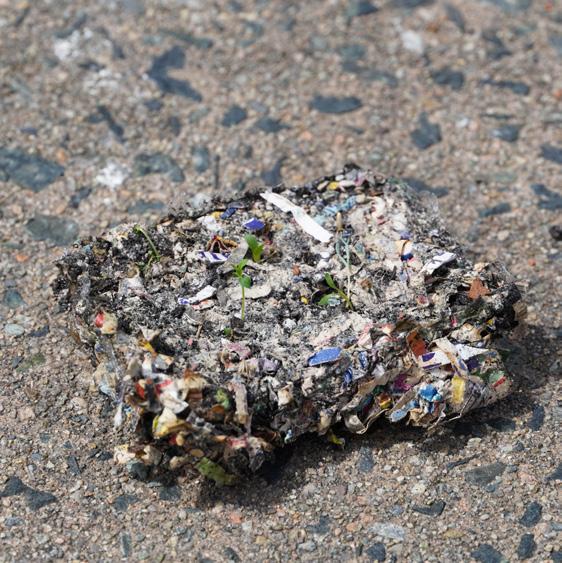

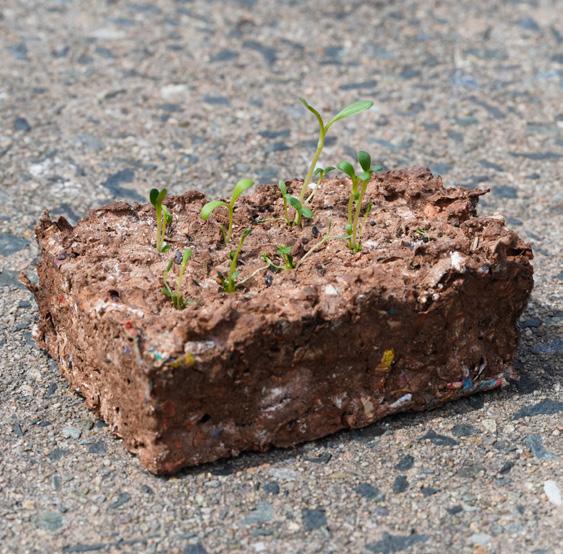

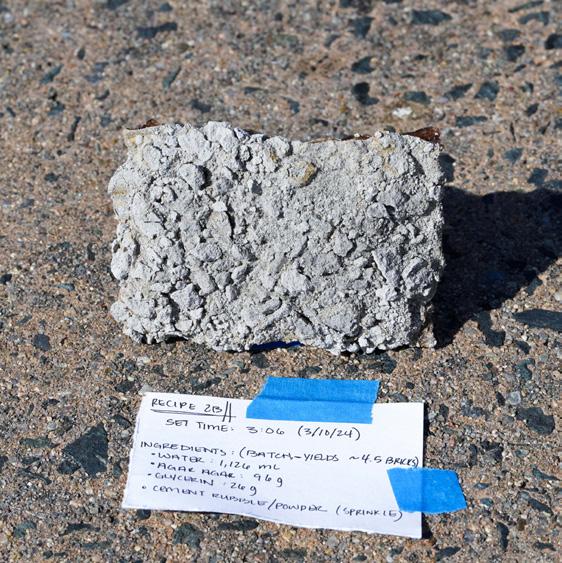
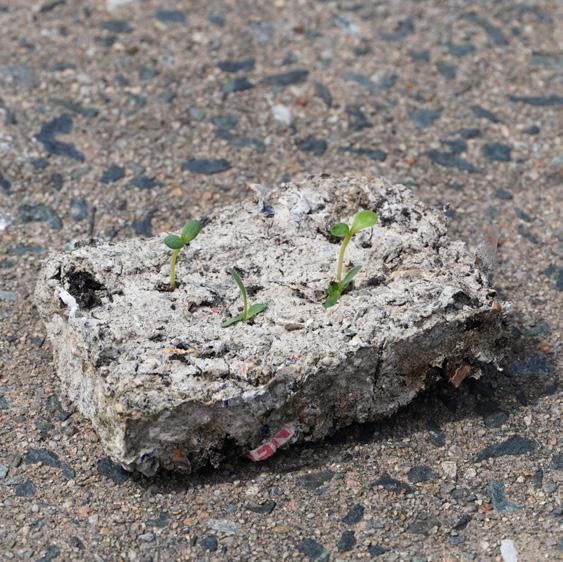

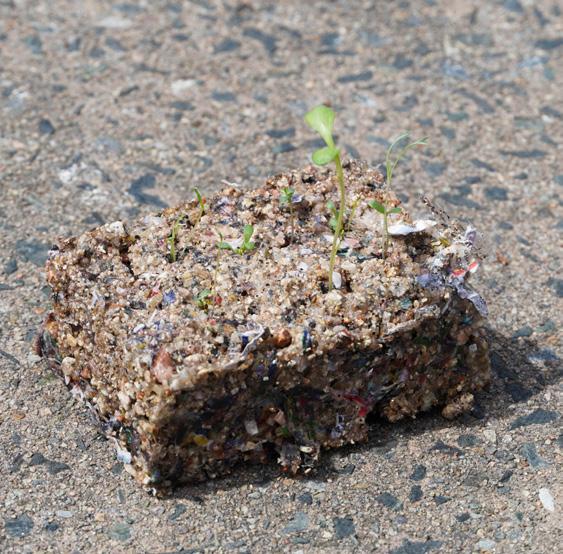
The second portion - the complex recipes - is an exercise in interventions.
Each intervention begins with a stamp print. This method of printmaking/working is employed to empower users with creative freedom, placing design agency in the hands of stakeholders and embracing the messiness of hands-on engagement with materials.

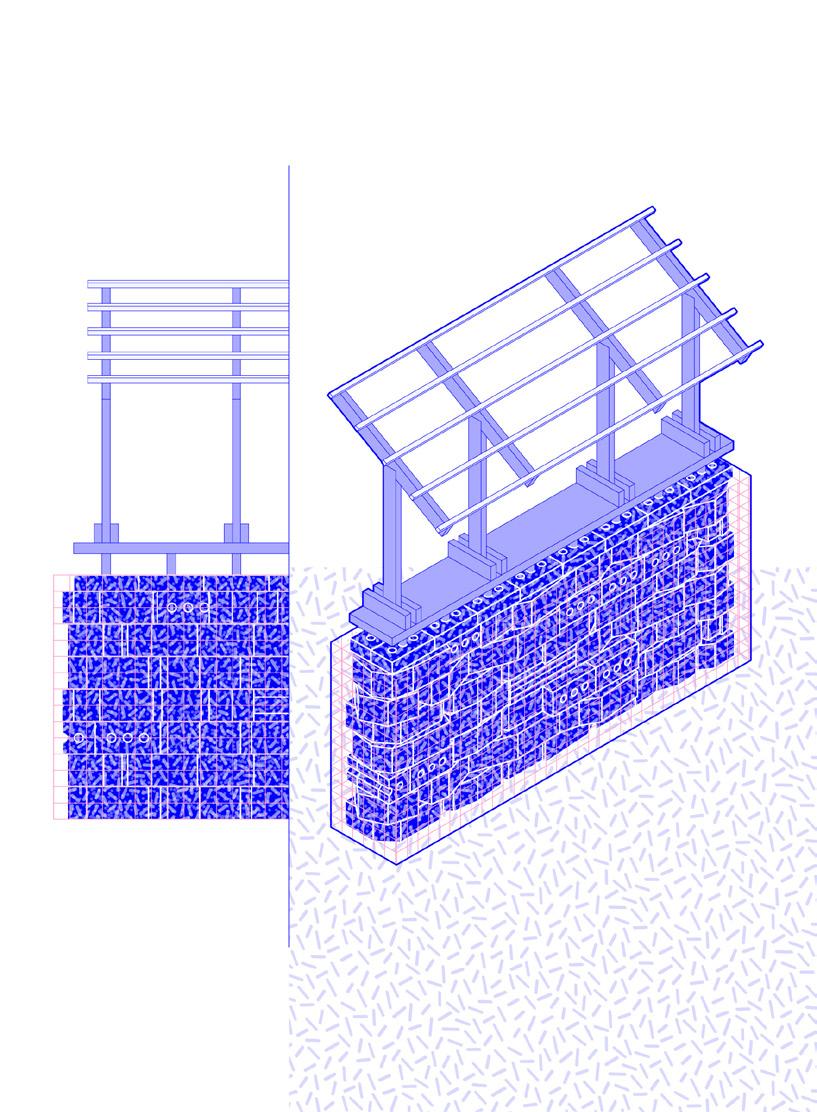


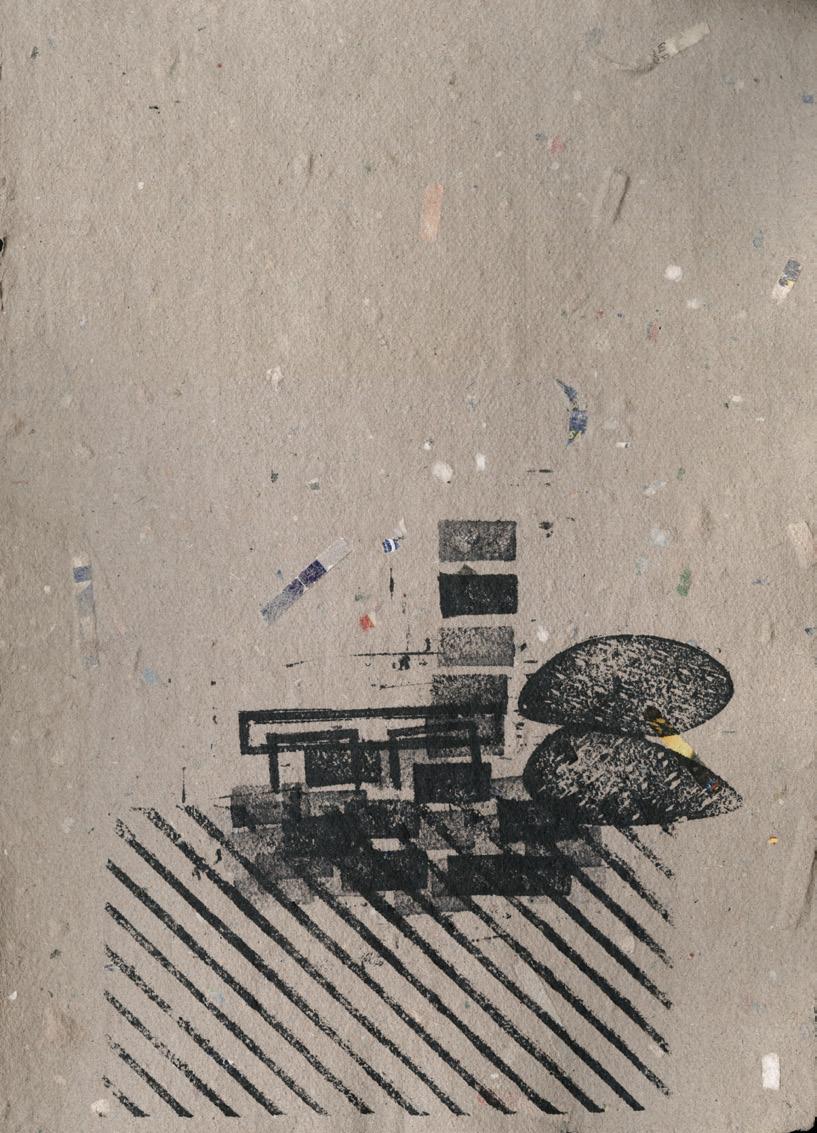
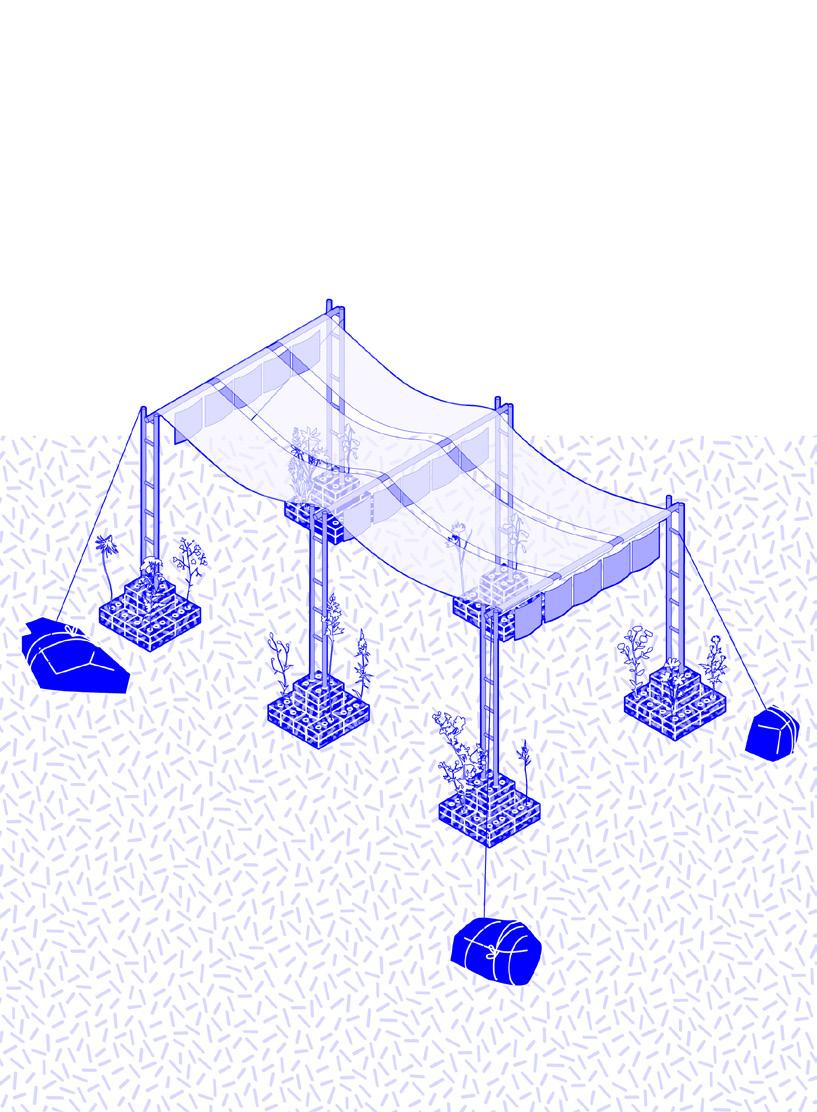
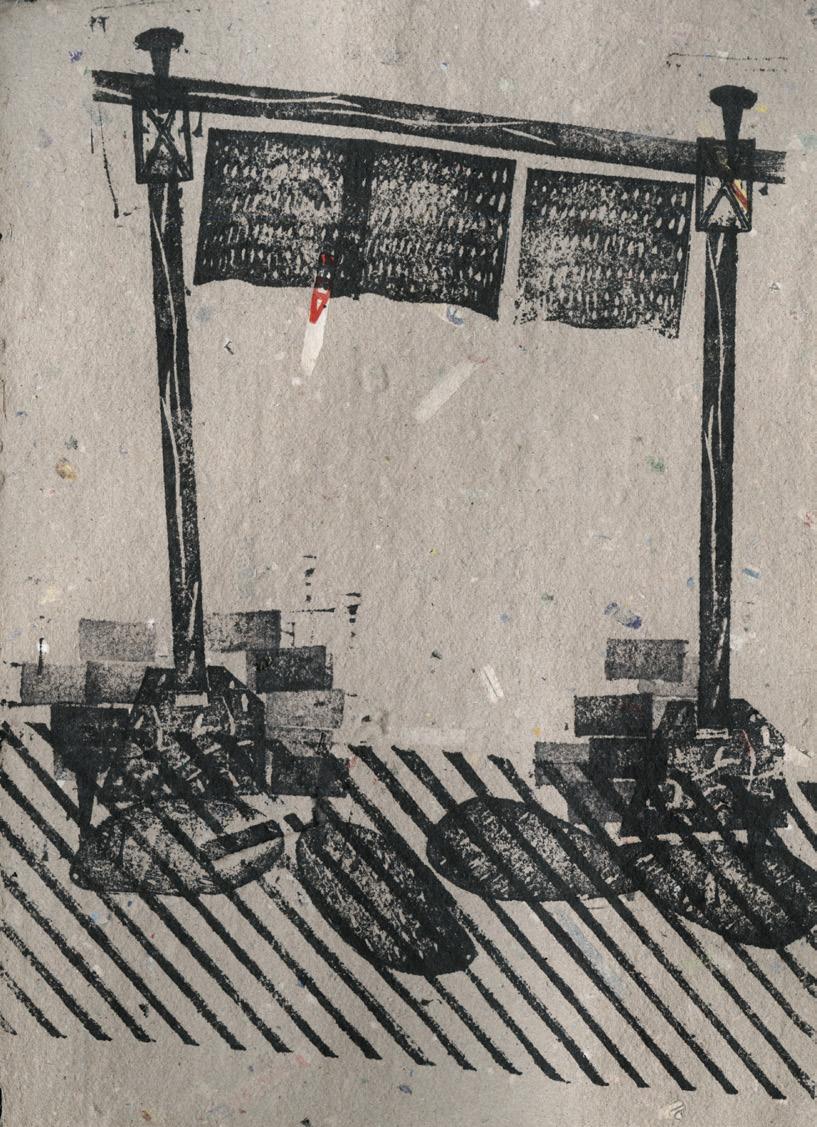


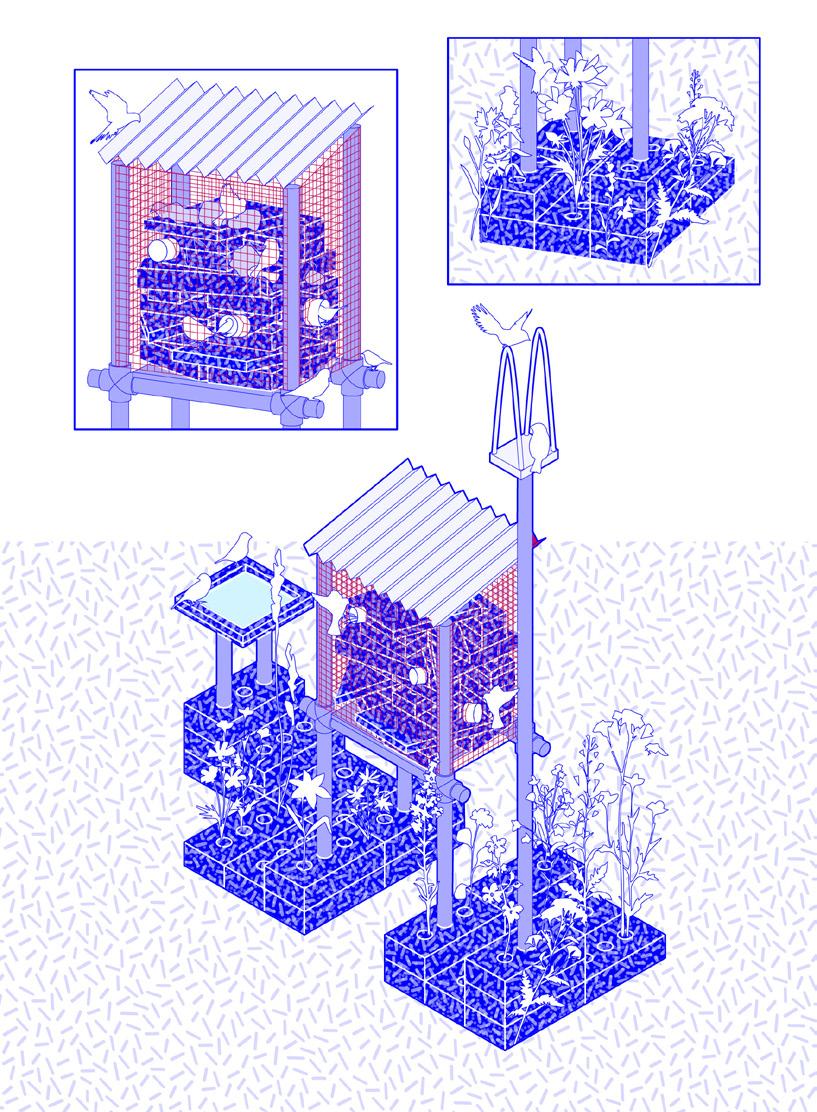
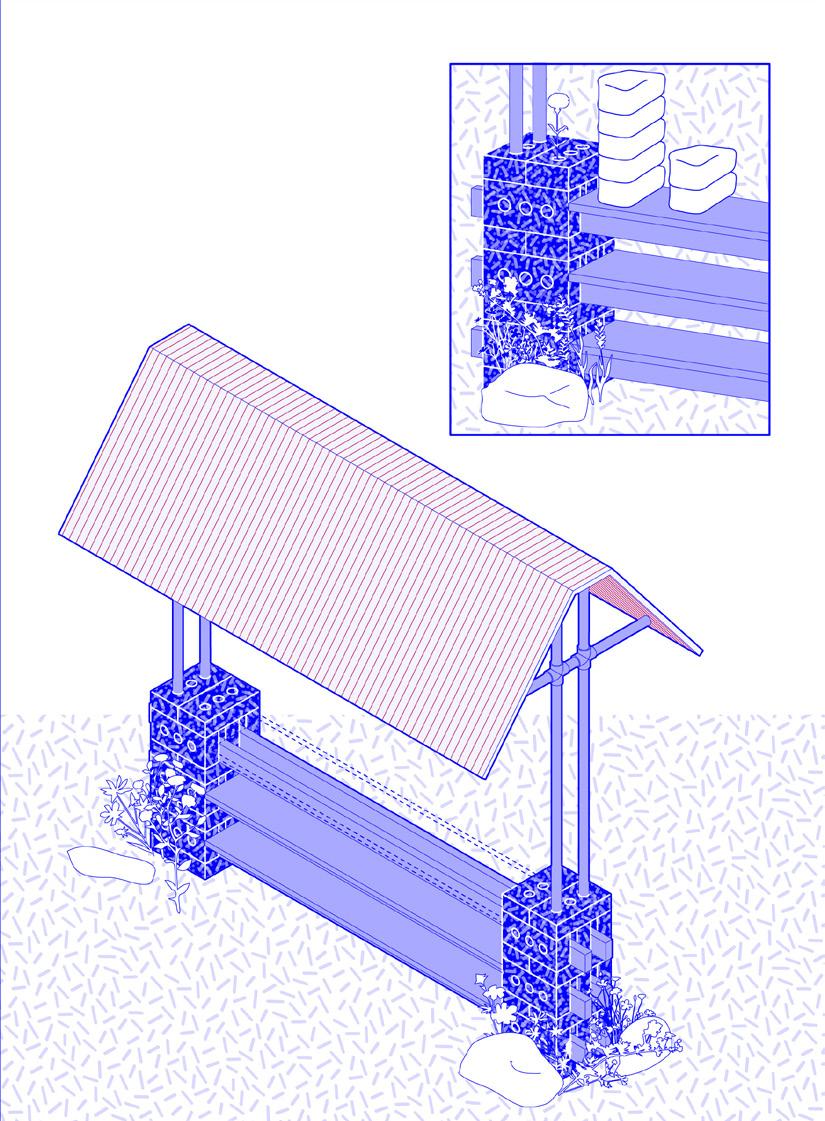
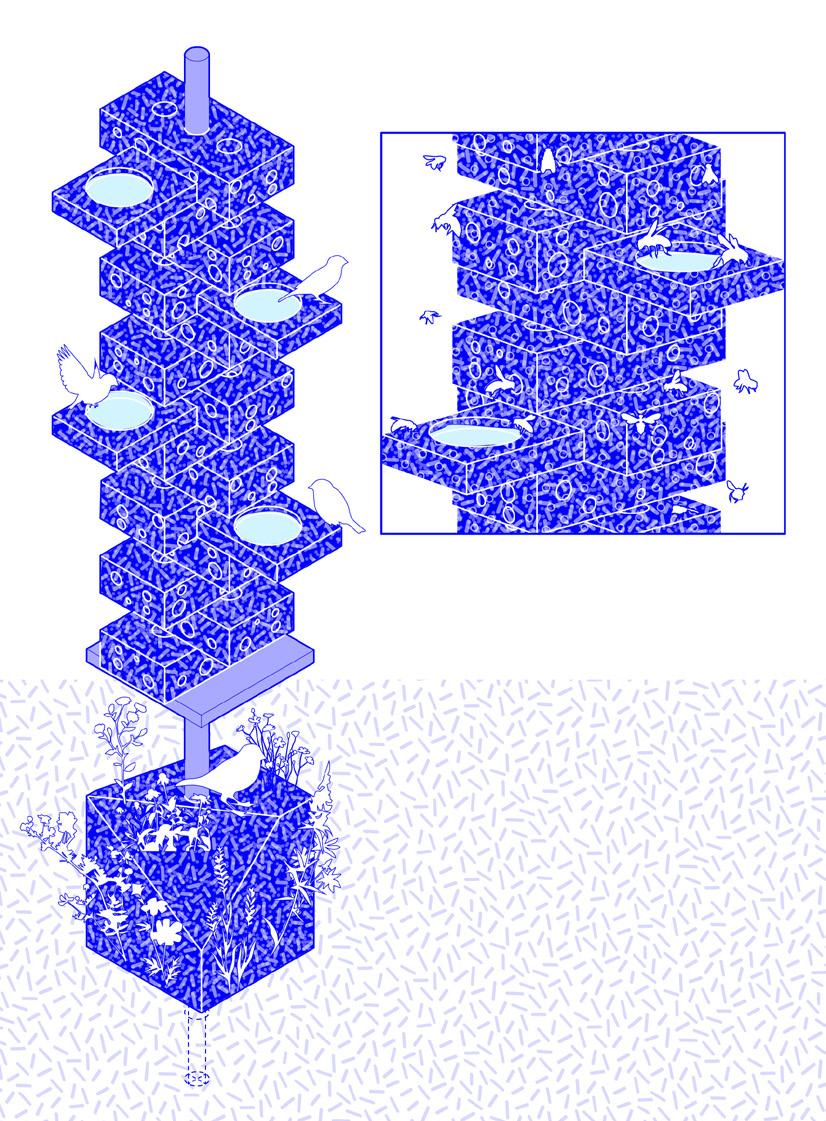

a.
(a)
(b) b.
5
SCALING UP
Urban Acupuncture
When scaling up, the cookbook and field notes are utilized to help community members and stakeholders to begin the process of revitalizing the arroyos.
The practice of incremental depavement and change through the slow reuse of the materials by individuals and community members thus begins. And while the beginnings may be slow...
c.
(c)
Year: 2024
Season: Autumn
Occasion: Beginnings of Change
Changes are being made. With the growing network of collaborators and stakeholders alongside the database of recipes and ideas, objects and structures that invite interaction, rest, and play can populate the landscape while also freeing up the ground to be revitalized slowly and allow flora and fauna to return
e.
Year: 2030
Season: Summer, Monsoon
Occasion: Rest + Sediment Collection
Year: 2040
Season: Winter
Occasion: Luminarias, River of Lights
(d) d.
g. h.
Year: 2080
Season: Autumn, Work Occasion: Balloon Fiesta, Burning of Zozobra, Sediment Harvest
Year: 2124
Season: Summer, Monsoon Occasion: Rest + Sediment Collection
(g)
(h)
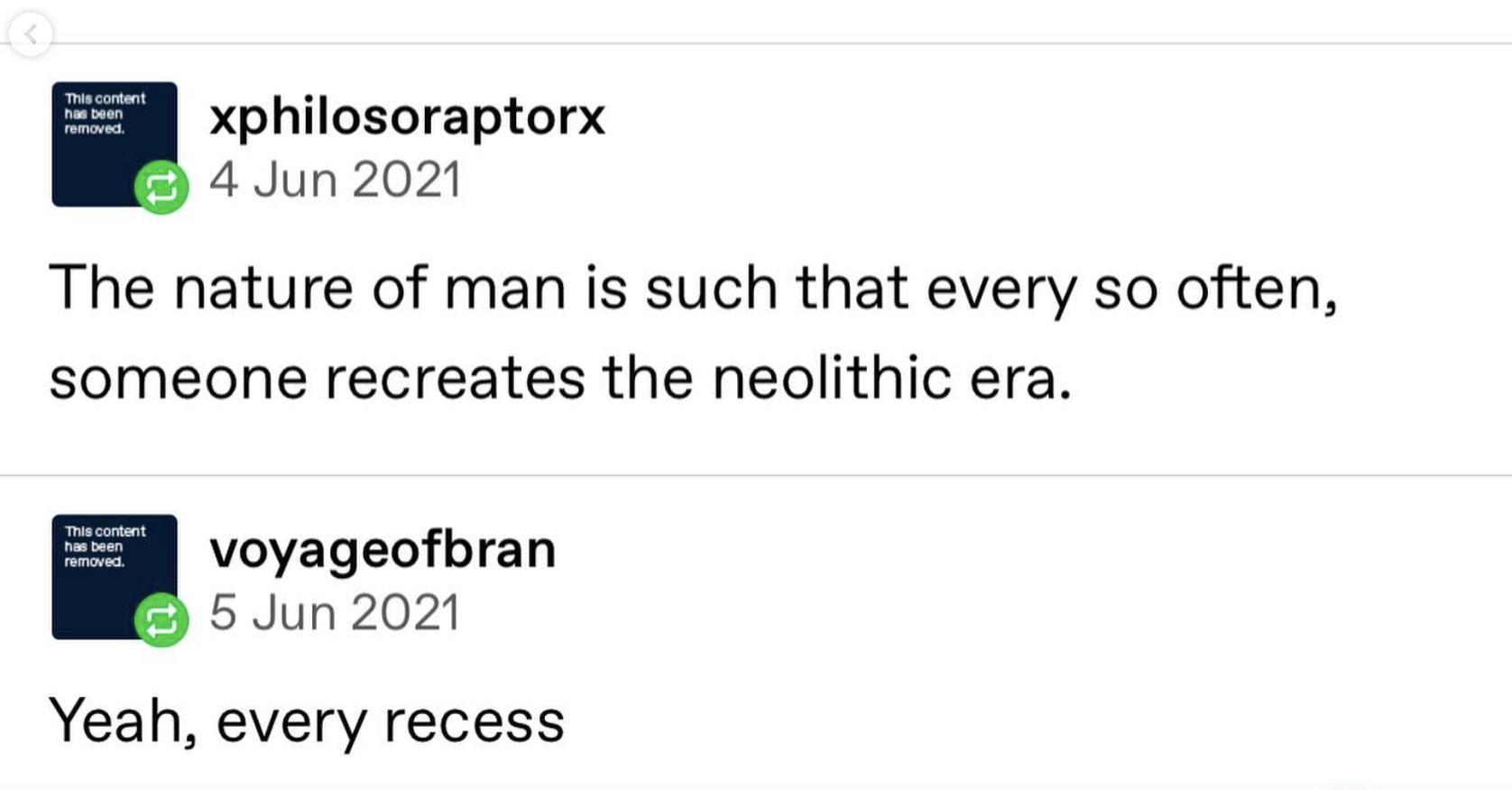
A screenshot of a 2021 Tumblr post posted by @makkaxchin on Instagram. Found via the explore page.
WHERE TO BEGIN?
A Case Study
6

Collet Park Elementary School
Elementary, middle, and high schools that are located on or adjacent to the arroyos
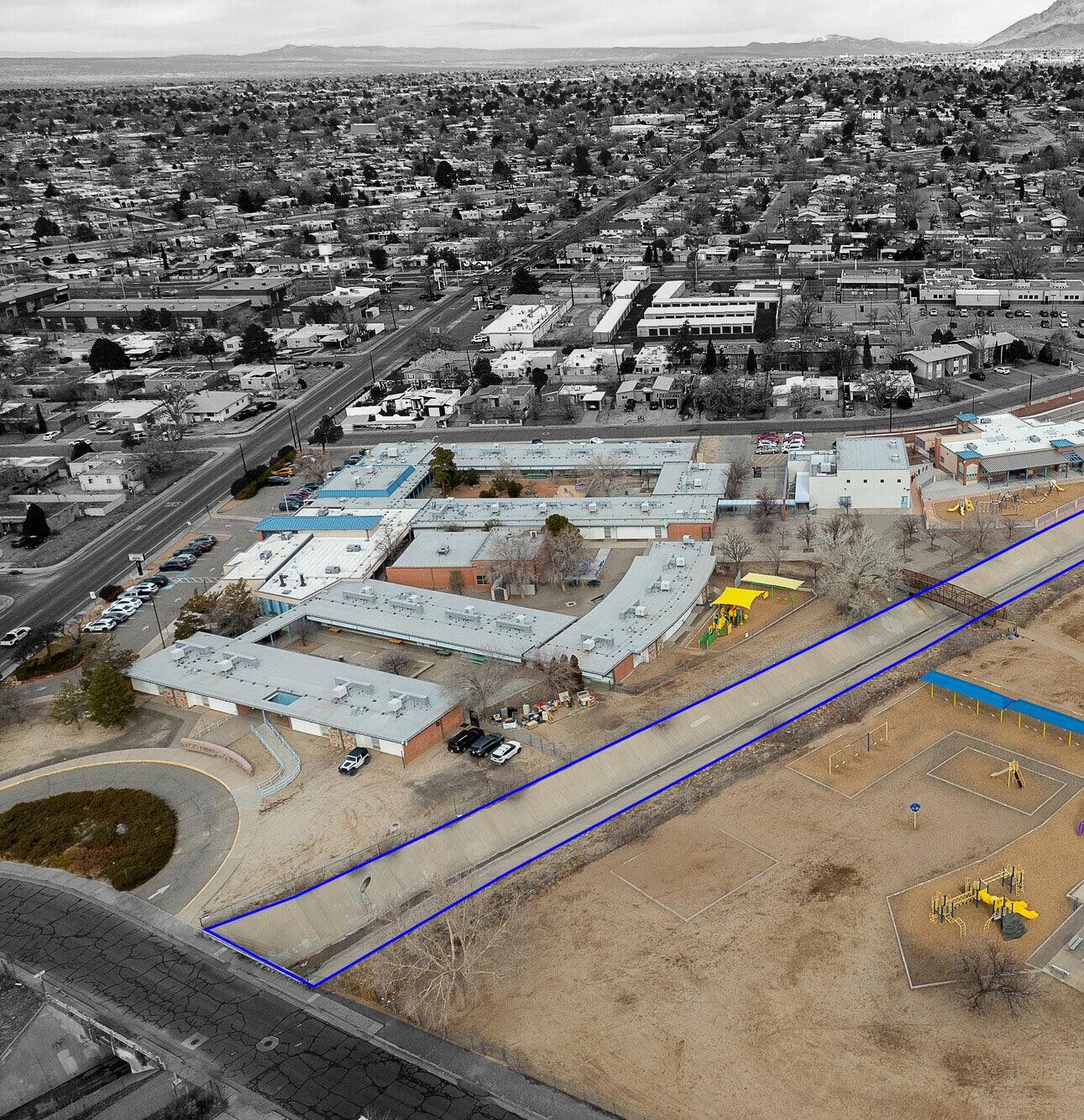
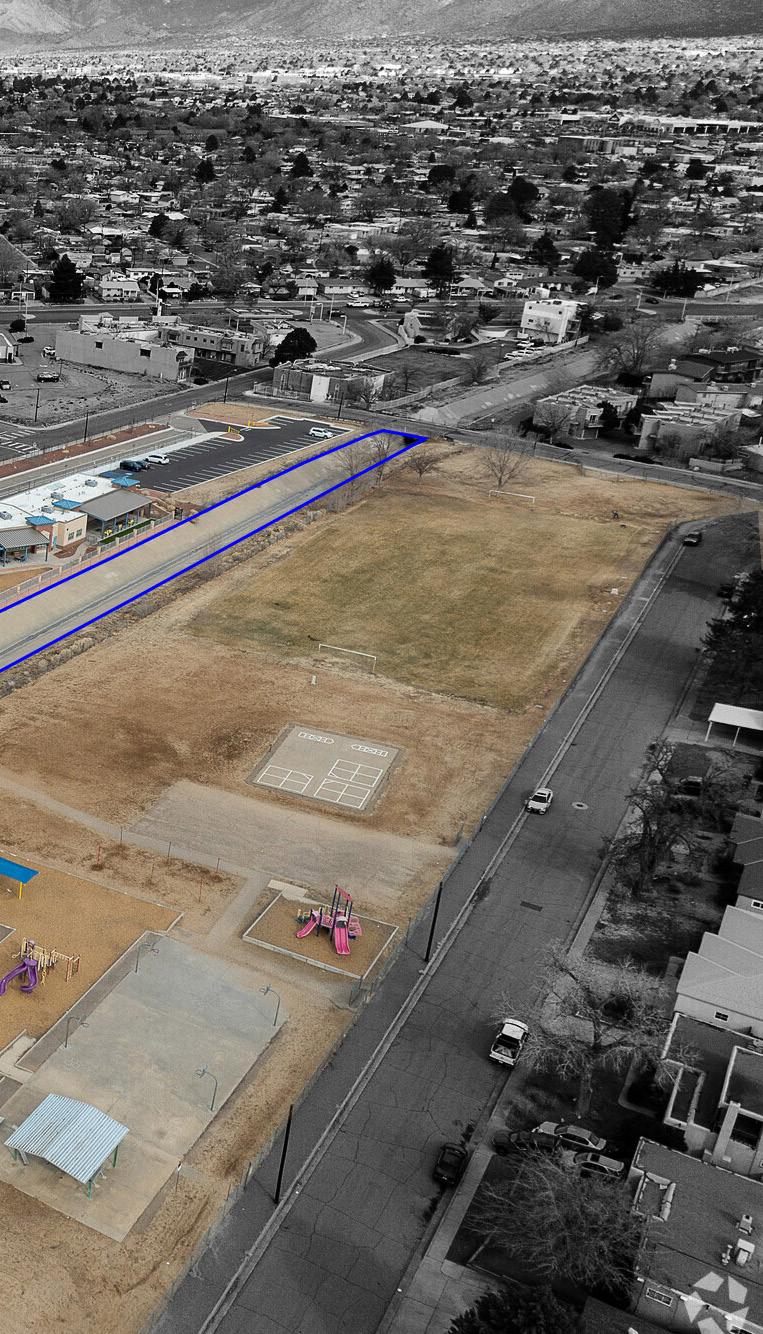
As a case study, I chose to examine Collet Park Elementary School.
Here, an arroyo channel bisects the property, dividing the playground from the classrooms, with one bridge to connect them. This moment presents an opportunity to reimagine the space as one of both play and education, giving the students access to local ecosystems while at school.
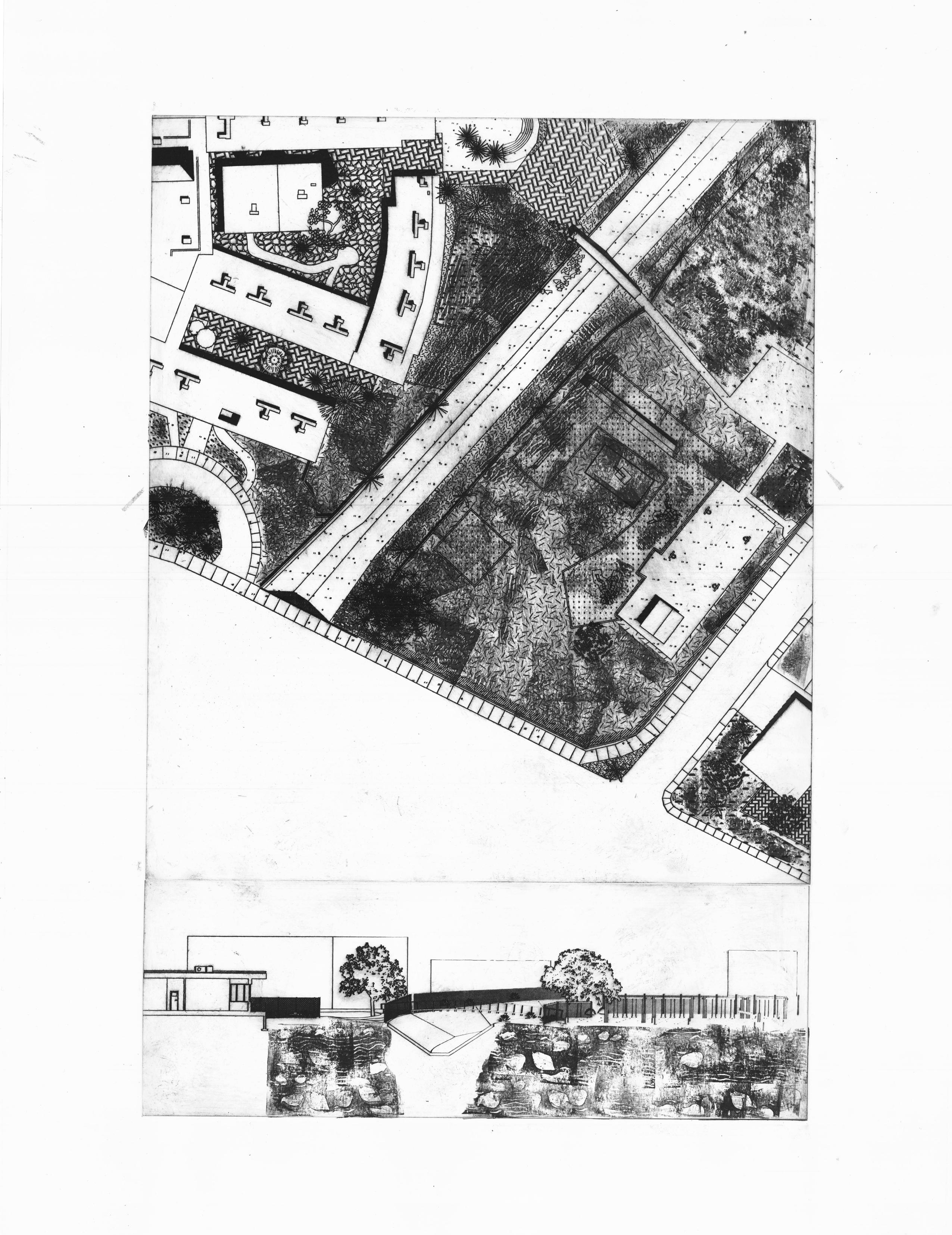
Year
2024
In cultivating these imagined futures, stamp printing techniques are once again utilized to help enable a hands on process to visualize the movement and “reassignment” of materials found on site – and how that can facilitate water absorption and land regeneration both in plan and section.
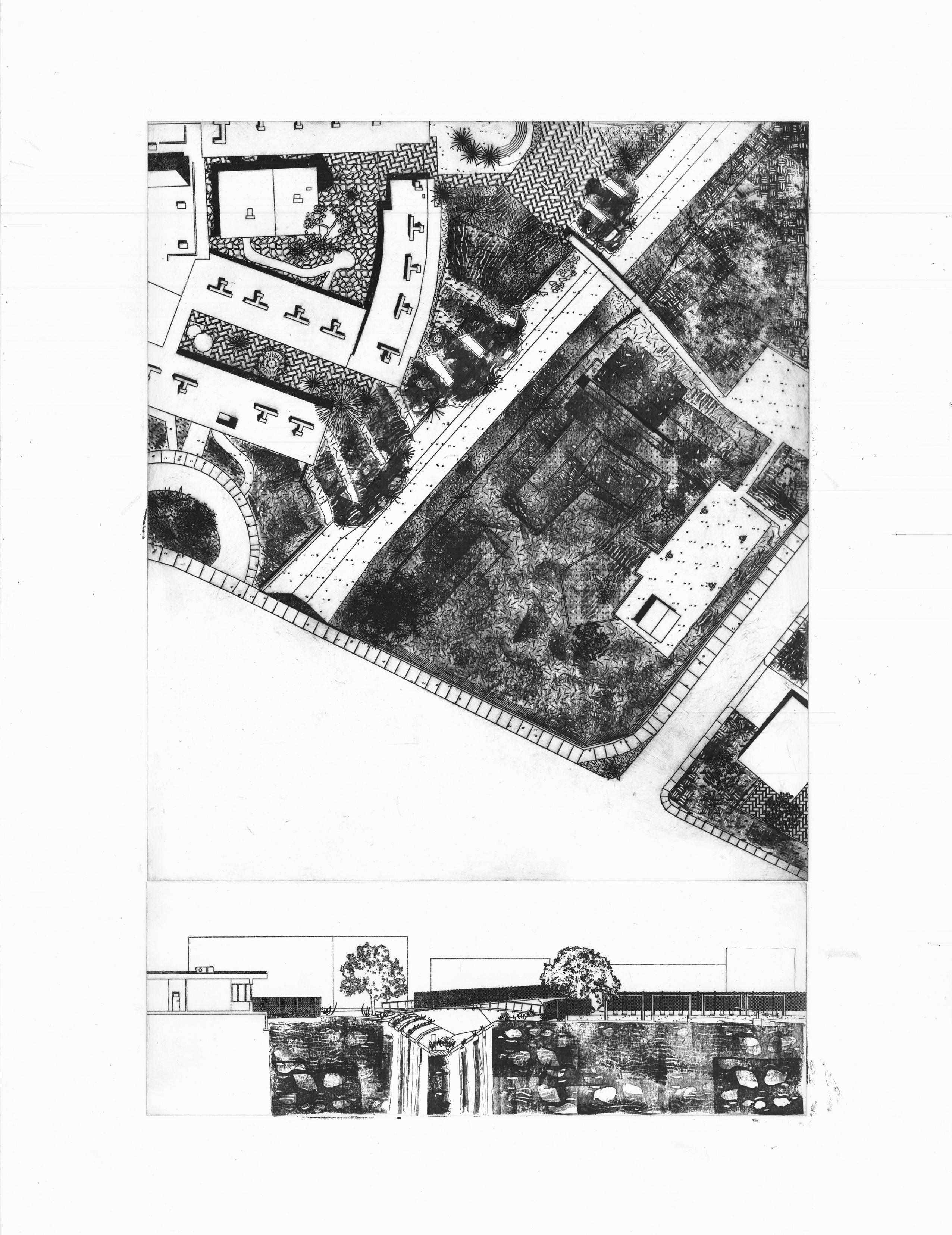
Year 2026

Year 2060

Year
2124
Overtime, the hard dividing line softens, giving spatial opportunities of congregation, play, and learning. There are four prints in total, each at a different “time stamp”.
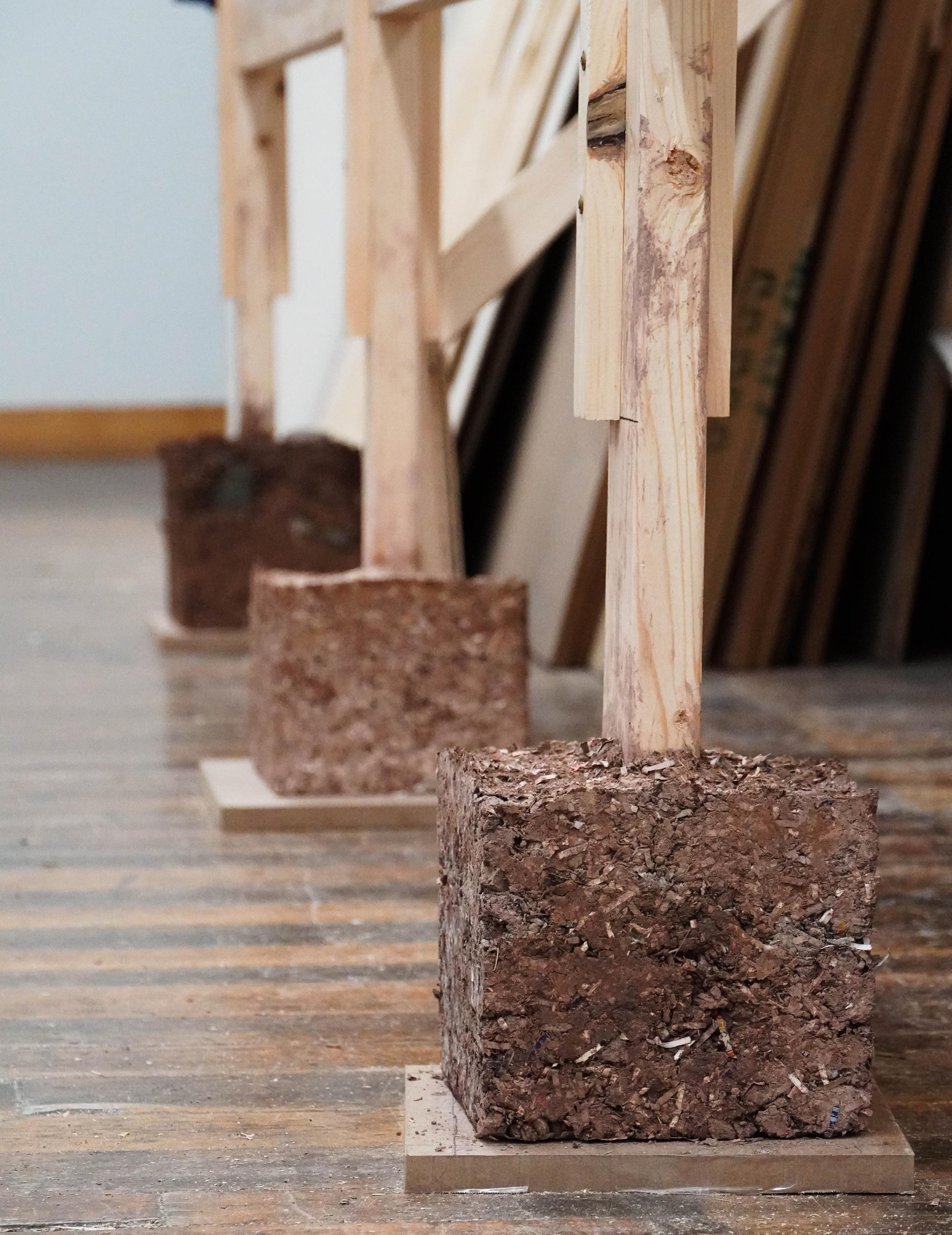
DESIGN IN PRACTICE
Exhibition, Joy of Collaboration
7
Concluding this book and thesis, is the exhibition structure itself. It was a meditation on the overarching ethos of the project - the joy of collaboration, sharing knowledge through an embodied process, and repurposing materials found “on site” (in this case the BEB). Teaming up with classmate and friend Lily Gucfa BArch 2024, we embarked on a process of trial and error of scavenging and testing the recipes at full scale, exchanging ideas along the way
 Cabinet Knob as Beam Support
Cabinet Knob as Beam Support
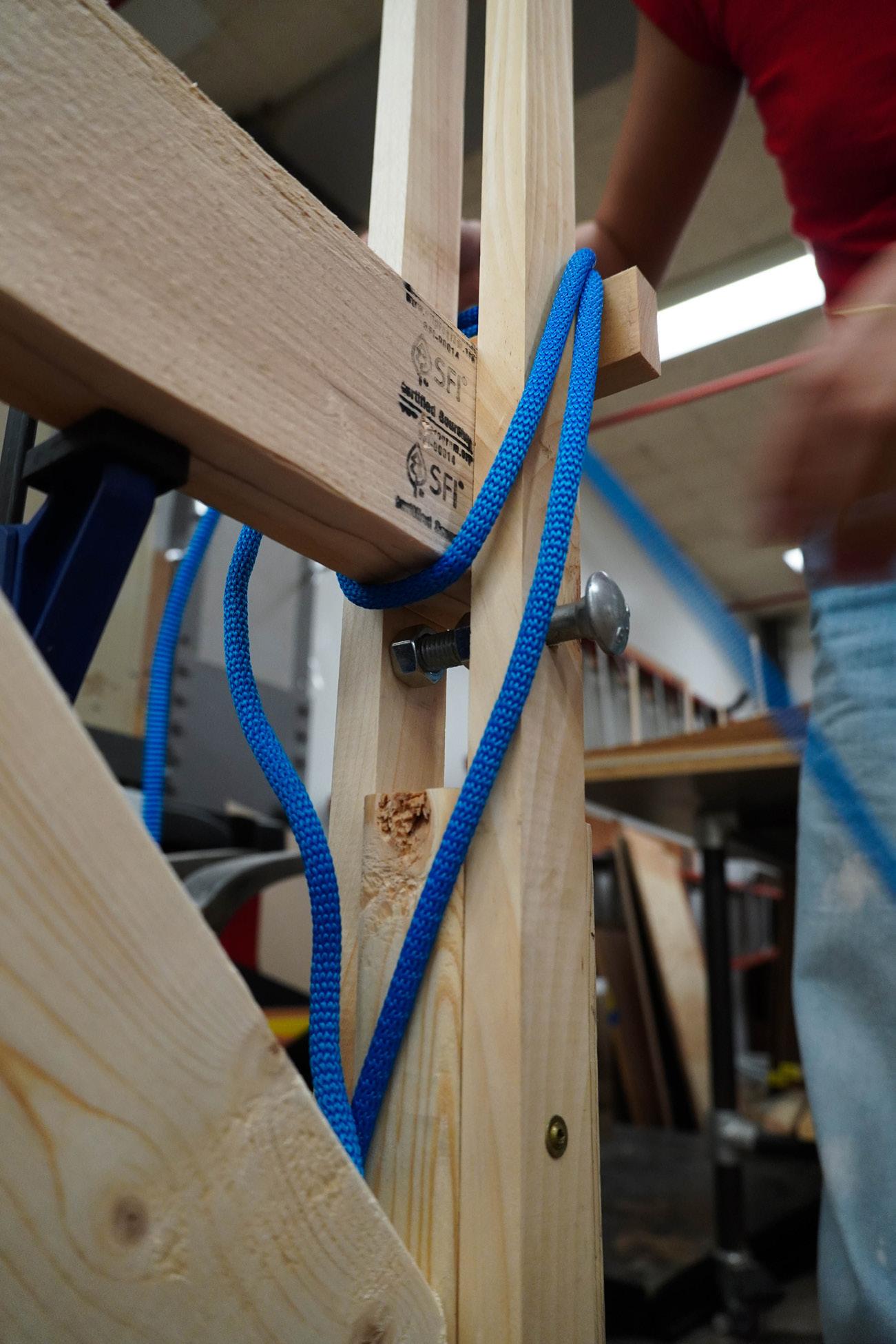 Rope and XL Bolt Used to Secure Beam
Rope and XL Bolt Used to Secure Beam
 Rocks in Wire Mesh “Bags” as Hanging Weights
Rocks in Wire Mesh “Bags” as Hanging Weights

Hardware to Prevent Bowing in the Two Pieces of Wood
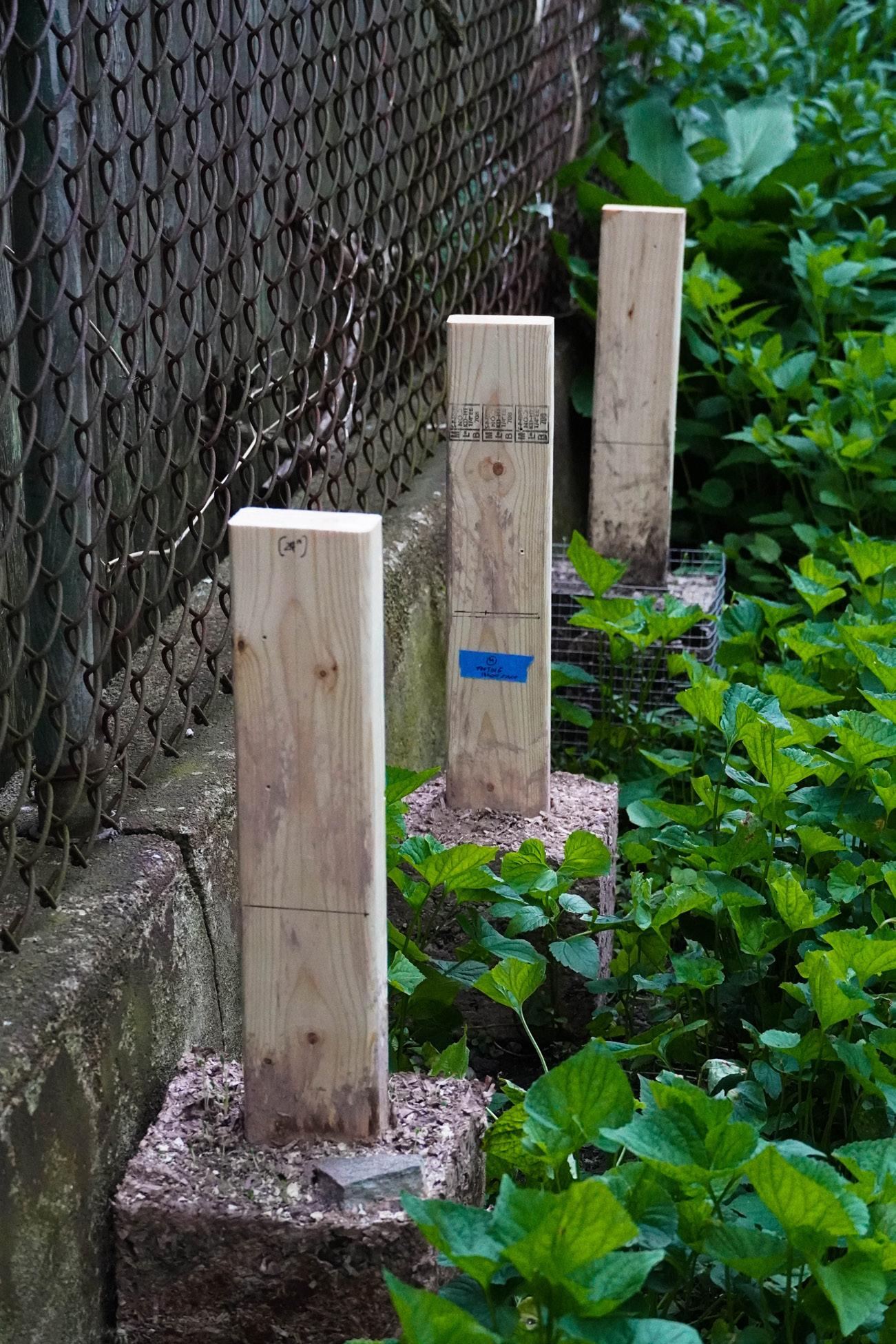
Footings Returning back to Where They Came From
 Lily and I
Lily and I
Thank you.
























































 Cabinet Knob as Beam Support
Cabinet Knob as Beam Support
 Rope and XL Bolt Used to Secure Beam
Rope and XL Bolt Used to Secure Beam
 Rocks in Wire Mesh “Bags” as Hanging Weights
Rocks in Wire Mesh “Bags” as Hanging Weights


 Lily and I
Lily and I